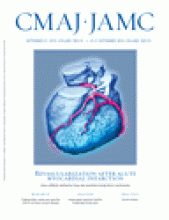The Checklist Manifesto: How to Get Things Right
Atul Gawande
Metropolitan Books/Henry Holt & Company; 2009.
In his latest book, Dr. Atul Gawande argues that modern medicine, with its immense web of complexity, might find an unlikely hero in the checklist. At first, it seems preposterous to suggest that ticking boxes off could have an impact on the current state of patient adverse events stemming from medical error which in the United States is estimated to cause 48 000 to 98 000 deaths 1 and in Canada causes about 18% of surgical complications. 2 It seems this is a case of oversimplification. However, in The Checklist Manifesto, Gawande pre-empts such criticism and offers a convincing argument that is both intellectually sound and eloquently written.
Medicine has simply become “too much airplane for one person to fly,” writes Gawande, drawing from an analogy of how B-17 bombers were once considered too difficult for pilots to fly until they discovered the use of the flight checklist. Readers of Gawande’s articles in The New Yorker will be familiar with his fascination with the airline industry’s use of the checklist. Gawande also draws inspiration from the construction industry, using it as an example of where multiple members of a team with complex tasks are able to work toward a common goal. The connection between the construction industry and surgery is clearly made. According to Gawande, solutions for patient safety do not come in the form of brand new discoveries, but in being able to implement what already exists. His genius lies in being able to recognize and use similarities between medicine and other professions.
This book also succeeds in highlighting the tremendous difficulties facing surgery internationally and the potential benefits of checklists. Despite the fact that the global burden of surgical disease (from broken bones, wound infections, and the like) is approaching that of well-known killers such as HIV, tuberculosis and childbirth, 3 not a lot of attention has been given to it. Gawande writes that while recent improvements in economic conditions among developing nations have translated into an increased volume of surgeries — in the order of 230 million cases per year — the rates of complications still remain very high. A good portion of the second half of the book is devoted to the development of the World Health Organization (WHO) Safe Surgery Checklist Program, which was spearheaded by Gawande, and born out of a lack of global guidelines on safe surgery. By taking his readers through a journey from the WHO headquarters where the checklist was conceived to the operating rooms of hospitals around the world in which they were implemented, Gawande demonstrates that it saves lives.
Image courtesy of Metropolitan Books/Henry Holt & Company
He also provides some insight into the often overlooked issue of the cultural context when practising medicine. For instance, Tanzanian hospitals have no access to surgical supplies in the rainy season because of transportation difficulties. And in Jordan there is a strict gender divide that makes its way to the operating room, minimizing communication between the mostly female nursing staff and the all-male surgical staff. Gawande reminds his readers that prepackaged health care, which ignores the local medical paradigm, is bound to fail in the global setting.
Those who pick up this book with the hope of being kept at the edge of their seats reading about Gawande’s medical adventures in the operating room will be disappointed: only a couple of chapters follow this narrative line. And even for those without these expectations, the chapters on safety in the construction and aviation industry are difficult reading. Admittedly, Gawande may have got a little carried away with his suggestion that if Warren Buffet, the financial investor, and several of the world’s best chefs can use checklists, so can surgeons. However, his point is not lost on the readers. What surgery and in fact all of medicine might be missing, is a disciplined approach to patient safety and more importantly, an unwillingness to admit that doctors have limitations in memory and judgement too. Like a lawyer making an impassioned case in court, Gawande makes a compelling case for the checklist.
Footnotes
-
Previously published at www.cmaj.ca












